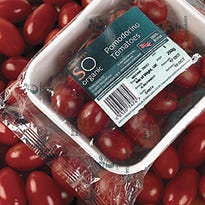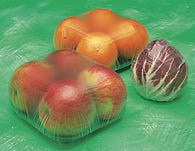April 2, 2015

NatureFlex™ cellulose-based films from Innovia can be used in flowrapping applications.
As an increasing number of brand owners begin to evaluate their product packaging for sustainability—whether to meet mandatory retail initiatives or to reap some of the rewards associated with greater environmental stewardship—one area of great interest is the use of bioplastics as a replacement for traditional, petroleum-based polymer packaging. But what exactly constitutes a bioplastic? And, how do bioplastics compare with synthetic polymers in real-world packaging applications? This month, Packaging Digest talks to Steven Mojo, executive director of The Biodegradable Products Institute to learn more about this rapidly growing category and some of the issues surrounding the use of these materials.
PD: When we use the terms "biopolymer" or "bioplastic," are we talking about a plastic material that is biobased, i.e. based on renewable materials?
Mojo: Some people will say that a biopolymer is a plastic that has a renewable content, and others will say that it is a material that is biodegradable, while others will say it's a little of each. Many products that are on the market today are combinations of petroleum-based and renewably based materials. "Biopolymer" is one of those terms that comes into the lexicon without being defined very well.
I believe the Japanese have announced that they are going to require a twenty-five-percent renewable content based on weight for many of these materials to be called biopolymers. But in the U.S., I don't know that we have defined the term biopolymer in any great detail.
The recent announcements by The Dow Chemical Co. and its Brazilian partner, Crystalsev, and by Braskem in Brazil, that they can now make traditional polyethylene from the renewable resources of sugarcane and ethanol are exciting new developments in the area of biopolymers. Now you can have a traditional plastic film that's based solely on renewable resources.

There's nothing that says that biopolymer materials need to be biodegradable, nor do they need to be 100-percent renewably based.
To me, there's nothing that says that biopolymer materials need to be biodegradable, nor do they need to be 100-percent renewably based. So you could have a blend of synthetic and renewable materials that don't biodegrade, or in the case of the Dow and Braskem materials, polyethylene that's fully renewable, yet will not biodegrade.
That's what makes this technology exciting, because you can look at combinations of fiber and renewable materials like PLA [polylactic acid] coatings on paper cups, and you get a fully compostable cup where biopolymers provide added value.
To learn more about SUSTAINABLE PACKAGING, visit PD's micro-site on the topic at /info/sustainability
The realm of biopolymers is still coming into fruition, and the term is evolving as technology moves forward. Frankly, I would urge manufacturers to be as specific as possible about claims such as renewable content and biodegradability or compostability.
PD: Can the various types of biopolymer resins on the market today be categorized?
Mojo: I think what you have to look at is the performance of these materials relative to the applications for which they are being used. For example, PLA resin, such NatureWorks® polymers from Natureworks LLC, tends to produce a very stiff, clear material. PLA has a lot of the characteristics of polystyrene and polyethylene terephthalate. On the other hand, Ecoflex®, a biodegradable material from BASF] that is made from petroleum, can also be very clear, but it's a very soft material, and it's suitable for making films and bags.

The new Mirel™ corn-sugar-based bioplastic from Metabolix and ADM is a PHA resin, used here for applesauce cups.
Another type of resin is PHA [polyhydroxyalkanoate]. [PHA resins are known as aliphatic polyesters, or a family of polymers that are made biologically by converting sunlight and carbon dioxide from the atmosphere using microbial or plant biofactories.] One example of a PHA is the new Mirel™ corn-sugar-based resin from Telles™, a joint venture of Metabolix and Archer Daniels Midland. PHA is said to be a lot like polypropylene as far as its properties and its potential applications are concerned.
From what I've seen, "starch-based" can refer to any material that contains starch. Typically these materials—and I'm thinking of Novamont's Mater-Bi™ material, in particular—are cloudy and translucent, not transparent. But I've also heard people talk about PLA as being starch-based. So, I don't try to categorize the feedstocks, other than renewable versus petroleum-based. What is most important when discussing the differences between various biopolymers is to understand their properties and their applications. It's like the differences between PE, PET, PP and PVC. There are many, many different types of resins, and each has benefits in certain types of applications. That's really the challenge in the market for converters: to understand which of these new resins will perform the way they want them to so they can create value for their customers.
PD: Is it true that using bioplastics in packaging may not always be a more sustainable solution than using traditional, petroleum-based resins?

Ecoflex(R), a biodegradable material from BASF that is made from petroleum, is suitable for making grocery bags.
Mojo: You need to look at the life cycles of these bioplastic materials. You need to look at their manufacture, as well as their use, and then at their disposal. And then you need to compare that to the incumbent materials. The most complete life cycles I've seen are the ones done by BASF, Natureworks and Novamont. As these companies have demonstrated, as the process for making these biobased materials is better understood and better defined, the life-cycle benefits begin to improve.
The original complaints that it takes too much energy to make these biobased materials compared with the incumbents may have been true. But you are looking at different levels of manufacturing in terms of the expertise and the knowledge and the quantity. So you're comparing a startup business to one that has been around for decades, and you're saying that this new material isn't as efficient as the older one. And yes, you're right, it is not as efficient, but that's not to say that it won't be someday.
PD: Can the terms "biodegradable" and "compostable" be used interchangeably?
Mojo: No, because one describes a process, while the other describes where and when the process will take place. When you say something is "biodegradable," it means that under the right conditions, microbes in the environment can completely break down the material and use it as a food source. Biodegradation is a process that can take place in many environments, including soils, compost sites, water treatment facilities, marine environments and even in the human body.

One application for Cereplast's starch-based resins is foodservice packaging.
This is the process that converts organic carbon into energy and maintains life. Not all materials are biodegradable under all conditions. Some are susceptible to the microbes found in a wastewater treatment plant, while others need the conditions and microbes found in a compost pile or in the soil.
When we say materials are "compostable," we are talking about where the process will occur and in what time frames. When products are designed to be composted, they should meet ASTM Intl. specifications D6400 (for Compostable Plastics) or D6868 (for Compostable Packaging). Products that meet the requirements in these two specifications will disintegrate rapidly in a professionally managed compost facility, will biodegrade quickly under the composting conditions, will not reduce the value or utility of the finished compost by leaving plastic fragments and will result in humus that supports plant life.
PD: While many biopolymers are marketed as being compostable, do we have the necessary infrastructure in place in the U.S. to process this type of waste?
Mojo: You are seeing a growing number of places that are doing food-waste diversion. Understand that the plastic products that are designed to be collected for composting are engineered to compost in conjunction with either food scraps or yard trimmings. We have 3,800 yard-trimming collection sites around the country, and we collect approximately sixty percent of our yard trimmings already. In the case of food-waste programs, there are not as many as we would like. According to the U.S. Environmental Protection Agency, we still send twenty-seven million tons of food scraps annually to landfills, where they contribute to greenhouse gas emissions and global warming.

PLA from Natureworks has been used for a number of beverage-packaging applications in the past several years.
But what you are beginning to see, not only in the U.S., but also in Canada, is a growing number of residential and commercial collection programs. For example, Seattle just announced the other day that it is going to begin residential collection of food scraps. You also see it in commercial situations such as grocery stores, where sixty percent or seventy percent of what they throw away is basically pre-consumer food waste. Not as much is happening on the East Coast, but that's not to say that people won't move to this process once they realize that they can save money by composting as opposed to landfilling.
If you have a reason to look for a compost facility in your area, you can generally find one. BioCycle magazine now has a website that provides a growing list of commercial composters, most of which will take food scraps. Natureworks' website also provides a list of food-composting facilities in the U.S.
Composting is one of those industries that's up and coming; you may not know about it, but it's happening a lot more.

Novamont's Mater-Bi(TM) starch-based material is cloudy in appearance.
PD: What future trends do you see for biopolymers?
Mojo: I believe that you will see the properties continue to get better. I think that converters will learn how to process them better, and as a result, the price for the end-application differential will continue to come down. I also think you will see a better understanding of what the life-cycle benefits are of these materials. And I believe that you'll continue to see the growth in food-waste diversion efforts—if people understand that food scraps, both pre- and post-consumer, are a resource that can be recovered and used as a feedstock for a process that's going to give them a useful product. Right now, we're just wasting those resources, and food scraps are one of the largest unrecovered waste streams that we have. When we send those to the landfills, they contribute to the production of methane, which is released into the atmosphere as greenhouse gas emissions. Landfills are the number-one generator of man-made methane into the atmosphere, according to the EPA.
Certainly in the past two to two-and-a-half years, sustainability in a variety of formats has grown in interest, from light bulbs to greenhouse gas to using less gasoline because the prices are higher. It is coming more to the forefront; it will be a question of how it plays out in the marketplace and how it translates into consumers' willingness to spend more for environmentally preferable choices. Some consumers are willing to spend a significant premium now, and others aren't. I think over time the premium will become more acceptable or will become smaller, and market penetration will increase.
Related Articles:
Green packaging primer
An overview of some of the terminology, drivers, standards, etc. associated with sustainable packaging materials.
CLICK HERE>>
PLA film shrinks to fit
Demonstrating excellent printability and machinability characteristics, sustainable, compostable polylactide film is now being converted by Seal-It, Inc. for use in shrink-sleeve label applications.
CLICK HERE>>
Steven Mojo is the executive director of The Biodegradable Products Institute, New York City, a multi-stakeholder association that promotes the use and recovery of biodegradable materials via composting. Through third-party testing in an approved laboratory, BPI certifies that products meet the requirements in ASTM D6400 or D6868, and identify them with the BPI "Compostable" logo.
More information is available:
The Biodegradable Products Institute, 888/274-5646. www.bpiworld.org
Archer Daniels Midland Co., 800/637-5843. www.admworld.com
ASTM Intl., 610/832-9500. www.astm.org
BASF Corp., 513/895-0446. www.basf.de/ecoflex
Braskem, 55-11 3443 9999. www.braskem.com.br
Cereplast, 310/676-5000. www.cereplast.com
Crystalsev, 55-16 2101 4400. www.crystalsev.com.br
The Dow Chemical Co., 800/441-4369. www.plastics.dow.com
Innovia, 877/822-3456. www.innoviafilms.com
Metabolix, Inc., 617/583-1700. www.metabolix.com
Natureworks LLC, 877/423-7659. www.natureworksllc.com
Novamont SPA, 39.0321.6996.11. www.materbi.com
U.S. Environmental Protection Agency, www.epa.gov.
About the Author(s)
You May Also Like


